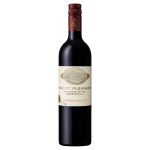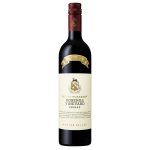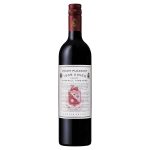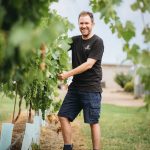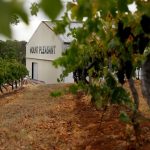It seems there is little Adrian Sparks, chief winemaker at Mount Pleasant Wines, can’t do.
Named Hunter Valley’s Winemaker of the year and picking up a swag of prizes for his 2017 1880 Old Vines Shiraz – it seems red wine is back at Mount Pleasant – a winery probably most famous for its semillon and chardonnay.
But, under Adrian’s guidance, the three reds coming to market this month: 2018 Mountain D Full Bodied Dry Red, 2018 Rosehill Shiraz and the 2018 1946 Vines Rosehill Shiraz, aren’t typical Hunter Valley heavyweight reds that assault the tastebud and the palate – instead these are softer, lighter more delicate and floral than the red wines we are used to.
- Mount Pleasant Wines 2018 Mountain D Full Bodied Dry Red. Image supplied.
- Mount Pleasant Wines 2018 Rosehill Shiraz. Image supplied
- Mount Pleasant Wines 2018 1965 Vines Rosehill Shiraz. Image supplied.
It’s hard to get good metaphors for wine because it’s a curious combination of art, science, weather, nature and the gift of the winemaker, so talking about soil types, sunlight hours and winemaking methods is a bit like describing the works of Monet by listing the chemicals in his paint. Instructive, but a bit useless.
Instead, I’m going to turn to music to try and help you understand these wines and decide whether you might like them or not.
Now, if I was truly skilled in using music as a metaphor, I would probably turn classical or opera to describe these wines, because like all good wines they are full of nuance and subtlety. But I don’t know much about classical music, despite being subjected to it for hours in the 1970s when every week a new record from Deutsche Gramaphon would turn up and my father would enthusiastically play it on our relatively crappy stereo.
Using music from 1960 – 1990 – my peak listening period – I’m going to choose a single band to define these light reds – all of which are sourced from the same vineyard.
When I was thinking about this I was torn between The Electric Light Orchestra or the Bee Gees. In this case the Bee Gees, because they are Australian and they possess great range.
- Mount Pleasant Wines Adrian Sparks. Image supplied
- Mount Pleasant Wines. Photographed by Chris Elfes. Image supplied.
That’s the thing about heavy reds – if I was using a style of music to describe them it would be rock and roll or maybe even punk rock because to me, at least, they aren’t about a light touch – but about force. Heavy reds are Cold Chisel, Rose Tattoo or the Angels and these aren’t.
Here’s the thing to remember about the Bee Gees, you might remember them from their disco era, or their 1970’s slow dance anthem era, but there is a lot more to them like a summer red – complex, nuanced and varied.
To sample these reds I invited friends who like wine, I cooked steak and arranged all three in different glasses in front of everybody and didn’t tell them what was what. Just asked them what they thought.
We started on the 2018 Mountain D Full Bodied Dry Red ($75), which is a blended red. Blended wines are where the winemakers’ skill comes forward – finding groups of complimentary grape styles and turning them into magic. In this case, it’s Mountain D, smooth and silky on the palate without any punch in the face heavy red overtones.
If this were a BeeGees song, it’s one of those songs you’ve forgotten and didn’t even know they had written. In this case, it’s Spicks and Specks, deceptively simple and really pretty enjoyable.
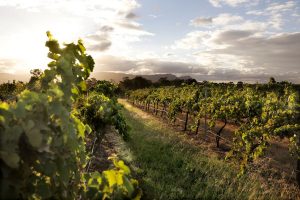
Mount Pleasant Wines. Photographed by Chris Elfes. Image supplied
Now this wouldn’t be a review if we didn’t rank the wines. Of the four people testing the three wines (Mountain D, Rosehill and 1946) we all liked the Mountain D the least. It’s a very good wine, but not as good as the other two.
And here’s where we are torn: on the final two, the Rosehill Vineyard and the 1946, two tasters liked the Rosehill best and two the 1946.
The 2018 Rosehill Shiraz ($50), which is from one of the premier vineyards in Australia with a northerly aspect, ancient volcanic soils was of the three, the wine with the most punch, with the biggest red traits and the people who liked it, admitted they were big red fans. If this is a Bee Gees song, it’s Stayin’ Alive, the rockiest thing they ever did, at least when disco was king.
Our second pick of the bunch was the 2018 1946 Vines Rosehill Shiraz ($135). Named 1946 after the year that the wines were first planted, this Rosehill Shiraz is a light, fruitful and graceful wine which will be a great summer drink this year and probably for the next 20 years to come.
Here’s the thing, the biggest selling song by the Bee Gees was You Should Be Dancing released in 1976 part of Saturday Night Fever’s soundtrack. I don’t think it’s anything like the best thing they ever did, for me, this wine is like their 1967 song The New York Mining Disaster produced by Robert Stigwood. Complex, layered and will remain great for the next 50 years.
Log onto Mount Pleasant Wines and buy a bottle. It’s worth it.


